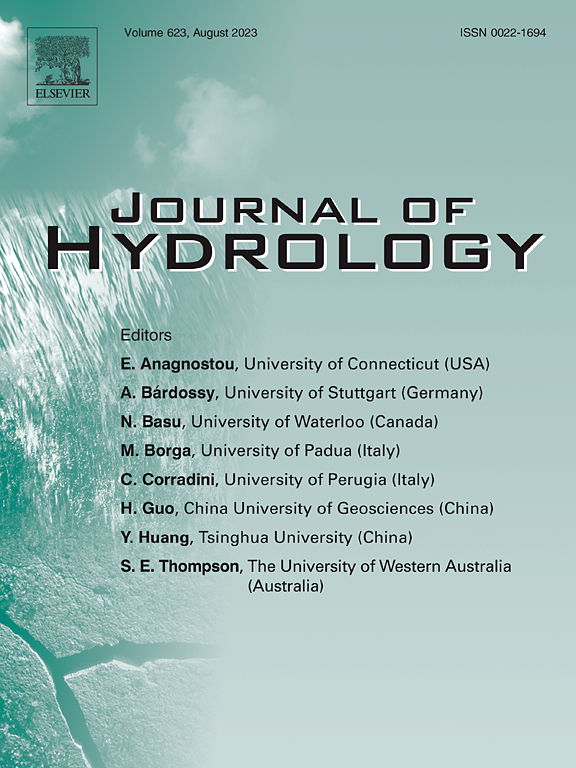The dynamic processes of CO2 migration as influenced by moisture and temperature in the arid sandy shrubland vadose zone
IF 6.3
1区 地球科学
Q1 ENGINEERING, CIVIL
引用次数: 0
Abstract
Desert ecosystems have recently garnered significant attention from scientists due to their potential to reduce carbon sink deficits and mitigate climate warming. However, limited attention has been given to the migration of CO2 in the subsurface of these ecosystems. In this study, continuous monitoring of CO2 concentrations, volumetric soil water contents (VWC), and soil temperatures (Ts) was performed at depths of 20, 50, and 100 cm within the root zone of Salix psammophila. The SOILCO2 module integrated into HYDRUS-1D was utilized to assess spatiotemporal variations in soil CO2, its dynamic processes, and responses to extreme meteorological conditions. The results indicate that soil CO2 concentrations, production rates, and fluxes throughout the soil profile followed clear temporal trends related to air temperature (Ta) and soil temperature (Ts) during the growing season. They began to rise in May, peaked in July and August, and then gradually decreased afterward. Moreover, rainfall regulated the real-time fluctuations of CO2 concentrations, production rates, and fluxes throughout the soil profile. Droughts and extreme rainfall events primarily impact soil CO2 fluxes due to changes in gas diffusion and microbial activity within the soil. Increases in rainfall-induced soil moisture stimulate soil CO2 generation (via microbial activity) but impede its upward migration (via gas diffusion pathways restricted by decreased soil aeration), thereby enhancing CO2 concentrations. The soil-atmosphere CO2 exchange was primarily affected by processes occurring in the 0–50 cm soil depth, mainly the CO2 production. This study highlights the importance of understanding the water-heat-carbon coupling mechanisms in the root zone, which is crucial for elucidating soil carbon emission dynamics.
湿度和温度对干旱沙质灌丛带CO2迁移动态过程的影响
由于沙漠生态系统具有减少碳汇赤字和减缓气候变暖的潜力,最近引起了科学家们的极大关注。然而,对这些生态系统地下CO2迁移的关注有限。本研究在沙柳根区20、50和100 cm深度连续监测CO2浓度、土壤体积含水量(VWC)和土壤温度(Ts)。利用集成在HYDRUS-1D中的SOILCO2模块,对土壤CO2的时空变化、动态过程以及对极端气象条件的响应进行了评估。结果表明,在生长季节,土壤CO2浓度、产速率和通量与气温(Ta)和土壤温度(Ts)有明显的时间变化趋势。它们在5月份开始上升,在7月和8月达到顶峰,然后逐渐下降。此外,降雨调节了整个土壤剖面中CO2浓度、产速率和通量的实时波动。干旱和极端降雨事件主要是由于土壤内气体扩散和微生物活动的变化而影响土壤二氧化碳通量。降雨引起的土壤水分增加刺激了土壤二氧化碳的产生(通过微生物活动),但阻碍了其向上迁移(通过受土壤通气量减少限制的气体扩散途径),从而提高了二氧化碳浓度。土壤-大气CO2交换主要受0 ~ 50 cm土层发生的过程影响,主要是CO2的产生。本研究强调了了解根区水-热-碳耦合机制的重要性,这对阐明土壤碳排放动态至关重要。
本文章由计算机程序翻译,如有差异,请以英文原文为准。
求助全文
约1分钟内获得全文
求助全文
来源期刊

Journal of Hydrology
地学-地球科学综合
CiteScore
11.00
自引率
12.50%
发文量
1309
审稿时长
7.5 months
期刊介绍:
The Journal of Hydrology publishes original research papers and comprehensive reviews in all the subfields of the hydrological sciences including water based management and policy issues that impact on economics and society. These comprise, but are not limited to the physical, chemical, biogeochemical, stochastic and systems aspects of surface and groundwater hydrology, hydrometeorology and hydrogeology. Relevant topics incorporating the insights and methodologies of disciplines such as climatology, water resource systems, hydraulics, agrohydrology, geomorphology, soil science, instrumentation and remote sensing, civil and environmental engineering are included. Social science perspectives on hydrological problems such as resource and ecological economics, environmental sociology, psychology and behavioural science, management and policy analysis are also invited. Multi-and interdisciplinary analyses of hydrological problems are within scope. The science published in the Journal of Hydrology is relevant to catchment scales rather than exclusively to a local scale or site.
 求助内容:
求助内容: 应助结果提醒方式:
应助结果提醒方式:


